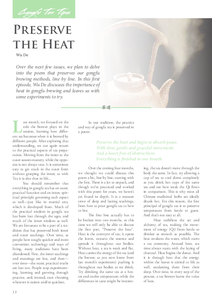
 |
|
Last month, we focused on the role the brewer plays in the session, learning how different tea becomes when it is brewed by different people. After exploring that understanding, we can again return to the practical aspects of tea preparation. Moving from the inner to the outer assures mastery, while the opposite is not always true. It is sometimes easy to get stuck in the outer form without grasping the inner, as with Tea it is also thus in life...
You should remember that everything in gongfu tea has an outer, practical function and an inner, spiritual principle governing each aspect as well - just like in martial arts, which it developed from. Much of the practical wisdom in gongfu tea has been lost through the ages, and much of the inner wisdom as well. We are fortunate to be a part of a tradition that has preserved both inner and outer teachings. Over time, as people have sought quicker and more convenient technology and ways of living, many traditions have been abandoned. First, the inner teachings and meanings are lost, and then - over time - the outer, practical truths are lost too. People stop experimenting, learning and growing through practice, and, instead, start choosing whatever is easiest and/or quickest.

In our tradition, the practice and way of gongfu tea is preserved in a poem:
Preserve the heat and begin to absorb peace,
With slow, gentle and graceful movements
And a heart free of obstructions
Everything is finished in one breath.
Over the coming four months, we thought we could discuss this poem a bit, line by line, starting with the first. There is a lot to unpack, and though we've practiced and worked with this poem for years, we haven't yet found its depth. It is a treasure trove of deep and lasting teachings, from how to pour gongfu tea to how to live.
The first line actually has to be broken into two months, so this time we will only be able to discuss the first part, "Preserve the heat". Heat is the conveyor of tea; it opens the leaves, extracts the essence and spreads it throughout our bodies. Without heat, a tea is weak and flat. Heat carries the energy of the tea (and the brewer, as you now know from last month's experiment) pushing it throughout our bodies as we drink. Try drinking the same tea at a hotter and cooler temperature; while the differences in taste might be interesting, the tea doesn't move through the body the same. In fact, try allowing a cup of tea to cool down completely as you drink hot cups of the same tea and see how weak the Qi flows in comparison. This is why most all Chinese medicinal herbs are ideally drunk hot. For this reason, the first principal of gongfu tea is to preserve temperature from kettle to guest. And that's not easy at all.
Heat stabilizes the art and alchemy of tea, making the movement of energy (Qi) from kettle to drinker as smooth as possible. The heat awakens the water, which starts a tea ceremony. Around here, tea time always starts with the laying of charcoal. Heat begins the dance. And it is through heat that the energy within the leaves is stirred to life as well, awakening them from their sleep. Over time, in every step of the process, a tea brewer learns the value of heat.

Fine teas always respond to higher heat, though you can sometimes produce a different kind of tea when brewing light teas at a lower temperature. If a green, white or yellow tea is of fine quality, however, it will not be ruined by hot water. That is a generalization. What happens, actually, is that a different kind of experience is evoked. In other words, it is a lateral rather than vertical shift when brewing a fine green tea with hot or cooled-down water. While it may be good advice for a beginner to brew white, green or yellow teas at lower temperatures, such instructions are not always based on personal wisdom or experience. And no general principle is true all of the time. There are always exceptions. If you have a fine green tea, try brewing it with hot water and cooler water. What are the differences? Is one better or just different? If the tea is low quality, then of course the cooler brew will be better as less is extracted (and less of a rough tea is less rough).
Upon arriving at our center, guests often feel the tea is too hot, as we use charcoal to heat our water. But within a few days, they begin to appreciate that when brewing most fine teas, the hotter the better. More heat means more Qi, more essence - more Tea! Most tea lovers will begin to gravitate towards hotter tea over time, especially if they are brewing tea gongfu.
For this month, try taking two of the same cups and preheating one before you pour tea liquor into both. The exercise is simple: preheat one cup with hot water before each steeping and don't preheat the other. Then drink them back and forth quickly, rather than trying to finish the whole of each cup consecutively. Just like in other experiments, and with all these gongfu tea tips, it is better if you use a tea that you are very familiar with. Otherwise, the newness of the tea will impair your ability to distinguish between the two. Also, brew the tea a bit lighter than you usually do. We hope these experiments can help you to begin to appreciate the value of heat in your tea and life...
